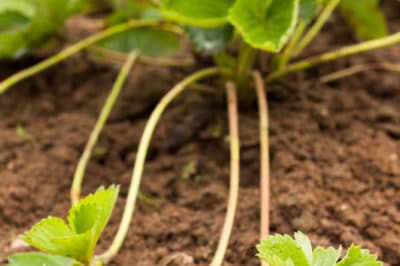Growing Strawberries
Strawberries can be grown in USDA Zones 3 through 11. You must choose the right varieties for your location and plan on protecting the plants with mulch in very cold areas. Perennials, they usually only produce good crops for about three years and should then be replaced. They need fertile, slightly acidic, well-drained soil and regular applications of organic fertilizer. Regular water is necessary for good crops.
About Runners
Strawberries belong to a group known as stolonaceous plants. These plants – which include mint, Bermuda grass and spider plant, among others – are perennials that reproduce through their stolons, or runners. Although some stolonaceous plants (like strawberries) also produce seed, the stolons are their primary reproduction method. Unlike plants grown from seed, each “daughter” plant is a clone of the original.
Strawberry Varieties and Runners
Certain types and varieties of strawberries produce fewer or more runners than others. Here are some examples:
- Ever-bearing strawberries generally produce fewer runners because they fruit twice a year.
- Day-neutral strawberries typically produce no or only a few runners.
- June-bearing strawberries produce lots of runners, as they only fruit once a year.
- Alpine strawberries may or may not produce runners, depending on the variety.
Runner Production
June-bearing strawberries don’t usually produce runners until after the fruit crop is finished. These plants grow in well-defined stages – bloom, fruit and then runners. Other types of strawberries may produce runners at different times of the year because they don’t fruit just once. However, in most cases, the majority of the runners will be produced in the summer and fall.
Runners and Matted Rows
Strawberries that produce runners freely are often grown in the matted row system. One or more rows of plants are planted in wide cultivated rows. They are allowed to grow the first season and any blossoms are removed to focus energy into the runners. The plants produce a harvest the next year and then are allowed to continue to spread. The fourth year, a new bed is created with new plants from the old bed, and the old bed is tilled under.
Encouraging Runners
While most strawberry plants will form runners without much encouragement, there are times you want a little extra. For example, you plan to create a new bed and want lots of plants for no cost. Make sure your plants have plenty of organic fertilizer. After the berry harvest, add supplemental nitrogen as that promotes leaf and runner growth. Pinch back blossoms and never let plants lack for water.
Runners But No Fruit
When your plants have lots of runners but little or no fruit, it could be because:
- They are too young.
- They are sick with an infection.
- They’re getting too much or too little water.
- Insects are not pollinating them.
- They need more/better fertilizer or less nitrogen.
- You’ve chosen a variety that doesn’t do well in your climate.
- You have a variety that doesn’t fruit heavily.
Pruning Runners
With the matted row system, you want to encourage runners to get more plants. However, if your focus is on maximizing berry production or you have limited space, you’ll need to prune the runners. It takes extra energy for the plant to produce runners. Check your plants at least once a week. As soon as you see a runner starting, pinch it off about one-half inch from the mother plant. You can prune runners at any time of year.
Pegging Runners
Strawberry runners are stolons that grow a little distance from the mother and then develop a new plant. It takes a while for new roots to form, but you can encourage them. Use a large woman’s hair pin or other piece of fairly heavy wire to keep the tip of the runner in firm contact with the ground. The wire should be close to the runner’s end. Keep the soil moist to encourage rooting.
Using Runners
Even if you don’t garden with the matted row system you might want to use runners to expand your crop. Once the berries have been harvested, allow your plants to produce runners. Meanwhile, prepare a new bed. In early fall, water the plants well. The next day, remove runners by cutting them from the mother plant and plant them in the new bed.
